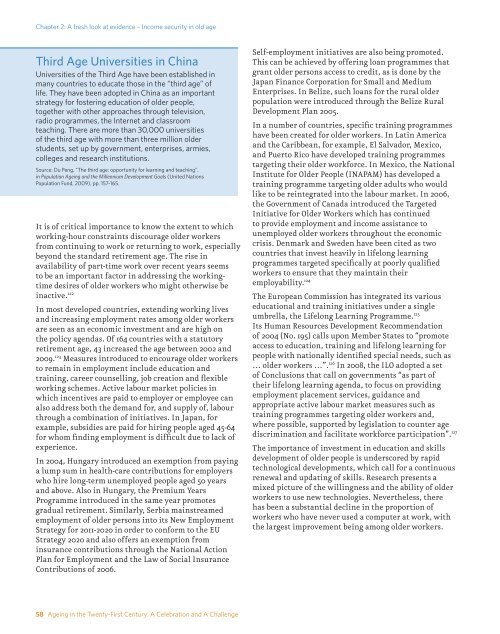Ageing in the Twenty-First Century: - HelpAge International
Ageing in the Twenty-First Century: - HelpAge International
Ageing in the Twenty-First Century: - HelpAge International
You also want an ePaper? Increase the reach of your titles
YUMPU automatically turns print PDFs into web optimized ePapers that Google loves.
Chapter 2: A fresh look at evidence – Income security <strong>in</strong> old age<br />
Third Age Universities <strong>in</strong> Ch<strong>in</strong>a<br />
Universities of <strong>the</strong> Third Age have been established <strong>in</strong><br />
many countries to educate those <strong>in</strong> <strong>the</strong> “third age” of<br />
life. They have been adopted <strong>in</strong> Ch<strong>in</strong>a as an important<br />
strategy for foster<strong>in</strong>g education of older people,<br />
toge<strong>the</strong>r with o<strong>the</strong>r approaches through television,<br />
radio programmes, <strong>the</strong> Internet and classroom<br />
teach<strong>in</strong>g. There are more than 30,000 universities<br />
of <strong>the</strong> third age with more than three million older<br />
students, set up by government, enterprises, armies,<br />
colleges and research <strong>in</strong>stitutions.<br />
Source: Du Peng, “The third age: opportunity for learn<strong>in</strong>g and teach<strong>in</strong>g”,<br />
<strong>in</strong> Population <strong>Age<strong>in</strong>g</strong> and <strong>the</strong> Millennium Development Goals (United Nations<br />
Population Fund, 2009), pp. 157-165.<br />
It is of critical importance to know <strong>the</strong> extent to which<br />
work<strong>in</strong>g-hour constra<strong>in</strong>ts discourage older workers<br />
from cont<strong>in</strong>u<strong>in</strong>g to work or return<strong>in</strong>g to work, especially<br />
beyond <strong>the</strong> standard retirement age. The rise <strong>in</strong><br />
availability of part-time work over recent years seems<br />
to be an important factor <strong>in</strong> address<strong>in</strong>g <strong>the</strong> work<strong>in</strong>gtime<br />
desires of older workers who might o<strong>the</strong>rwise be<br />
<strong>in</strong>active. 122<br />
In most developed countries, extend<strong>in</strong>g work<strong>in</strong>g lives<br />
and <strong>in</strong>creas<strong>in</strong>g employment rates among older workers<br />
are seen as an economic <strong>in</strong>vestment and are high on<br />
<strong>the</strong> policy agendas. Of 164 countries with a statutory<br />
retirement age, 43 <strong>in</strong>creased <strong>the</strong> age between 2002 and<br />
2009. 123 Measures <strong>in</strong>troduced to encourage older workers<br />
to rema<strong>in</strong> <strong>in</strong> employment <strong>in</strong>clude education and<br />
tra<strong>in</strong><strong>in</strong>g, career counsell<strong>in</strong>g, job creation and flexible<br />
work<strong>in</strong>g schemes. Active labour market policies <strong>in</strong><br />
which <strong>in</strong>centives are paid to employer or employee can<br />
also address both <strong>the</strong> demand for, and supply of, labour<br />
through a comb<strong>in</strong>ation of <strong>in</strong>itiatives. In Japan, for<br />
example, subsidies are paid for hir<strong>in</strong>g people aged 45-64<br />
for whom f<strong>in</strong>d<strong>in</strong>g employment is difficult due to lack of<br />
experience.<br />
In 2004, Hungary <strong>in</strong>troduced an exemption from pay<strong>in</strong>g<br />
a lump sum <strong>in</strong> health-care contributions for employers<br />
who hire long-term unemployed people aged 50 years<br />
and above. Also <strong>in</strong> Hungary, <strong>the</strong> Premium Years<br />
Programme <strong>in</strong>troduced <strong>in</strong> <strong>the</strong> same year promotes<br />
gradual retirement. Similarly, Serbia ma<strong>in</strong>streamed<br />
employment of older persons <strong>in</strong>to its New Employment<br />
Strategy for 2011-2020 <strong>in</strong> order to conform to <strong>the</strong> EU<br />
Strategy 2020 and also offers an exemption from<br />
<strong>in</strong>surance contributions through <strong>the</strong> National Action<br />
Plan for Employment and <strong>the</strong> Law of Social Insurance<br />
Contributions of 2006.<br />
Self-employment <strong>in</strong>itiatives are also be<strong>in</strong>g promoted.<br />
This can be achieved by offer<strong>in</strong>g loan programmes that<br />
grant older persons access to credit, as is done by <strong>the</strong><br />
Japan F<strong>in</strong>ance Corporation for Small and Medium<br />
Enterprises. In Belize, such loans for <strong>the</strong> rural older<br />
population were <strong>in</strong>troduced through <strong>the</strong> Belize Rural<br />
Development Plan 2005.<br />
In a number of countries, specific tra<strong>in</strong><strong>in</strong>g programmes<br />
have been created for older workers. In Lat<strong>in</strong> America<br />
and <strong>the</strong> Caribbean, for example, El Salvador, Mexico,<br />
and Puerto Rico have developed tra<strong>in</strong><strong>in</strong>g programmes<br />
target<strong>in</strong>g <strong>the</strong>ir older workforce. In Mexico, <strong>the</strong> National<br />
Institute for Older People (INAPAM) has developed a<br />
tra<strong>in</strong><strong>in</strong>g programme target<strong>in</strong>g older adults who would<br />
like to be re<strong>in</strong>tegrated <strong>in</strong>to <strong>the</strong> labour market. In 2006,<br />
<strong>the</strong> Government of Canada <strong>in</strong>troduced <strong>the</strong> Targeted<br />
Initiative for Older Workers which has cont<strong>in</strong>ued<br />
to provide employment and <strong>in</strong>come assistance to<br />
unemployed older workers throughout <strong>the</strong> economic<br />
crisis. Denmark and Sweden have been cited as two<br />
countries that <strong>in</strong>vest heavily <strong>in</strong> lifelong learn<strong>in</strong>g<br />
programmes targeted specifically at poorly qualified<br />
workers to ensure that <strong>the</strong>y ma<strong>in</strong>ta<strong>in</strong> <strong>the</strong>ir<br />
employability. 124<br />
The European Commission has <strong>in</strong>tegrated its various<br />
educational and tra<strong>in</strong><strong>in</strong>g <strong>in</strong>itiatives under a s<strong>in</strong>gle<br />
umbrella, <strong>the</strong> Lifelong Learn<strong>in</strong>g Programme. 125<br />
Its Human Resources Development Recommendation<br />
of 2004 (No. 195) calls upon Member States to “promote<br />
access to education, tra<strong>in</strong><strong>in</strong>g and lifelong learn<strong>in</strong>g for<br />
people with nationally identified special needs, such as<br />
… older workers …”. 126 In 2008, <strong>the</strong> ILO adopted a set<br />
of Conclusions that call on governments “as part of<br />
<strong>the</strong>ir lifelong learn<strong>in</strong>g agenda, to focus on provid<strong>in</strong>g<br />
employment placement services, guidance and<br />
appropriate active labour market measures such as<br />
tra<strong>in</strong><strong>in</strong>g programmes target<strong>in</strong>g older workers and,<br />
where possible, supported by legislation to counter age<br />
discrim<strong>in</strong>ation and facilitate workforce participation”. 127<br />
The importance of <strong>in</strong>vestment <strong>in</strong> education and skills<br />
development of older people is underscored by rapid<br />
technological developments, which call for a cont<strong>in</strong>uous<br />
renewal and updat<strong>in</strong>g of skills. Research presents a<br />
mixed picture of <strong>the</strong> will<strong>in</strong>gness and <strong>the</strong> ability of older<br />
workers to use new technologies. Never<strong>the</strong>less, <strong>the</strong>re<br />
has been a substantial decl<strong>in</strong>e <strong>in</strong> <strong>the</strong> proportion of<br />
workers who have never used a computer at work, with<br />
<strong>the</strong> largest improvement be<strong>in</strong>g among older workers.<br />
58 <strong>Age<strong>in</strong>g</strong> <strong>in</strong> <strong>the</strong> <strong>Twenty</strong>-<strong>First</strong> <strong>Century</strong>: A Celebration and A Challenge







